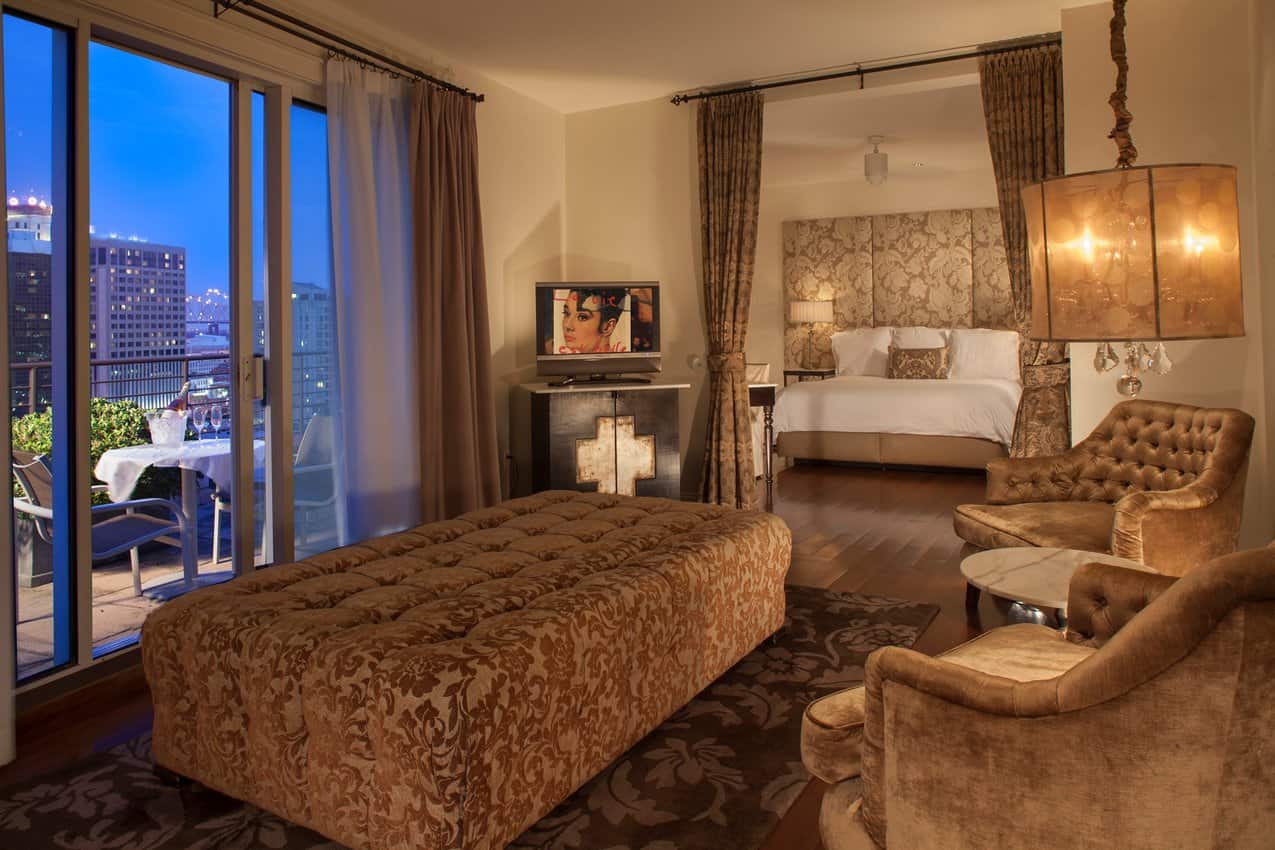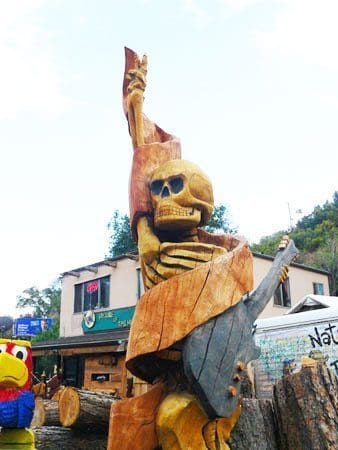
By Stephen Hartshorne
GoNOMAD Associate Editor
Just got back from the “Spooky Colorado” tour of the state’s most haunted locations, including the Stanley Hotel in Estes Park, made famous by Stephen King in his novel, The Shining.
While some spirits haunt places where they’ve been trapped by acts of violence and passion, many spirits return to places where they had a good time and felt at home while they were alive.
I think that’s why there’s so much paranormal activity in Colorado. It’s one of the most beautiful places in the world, and it’s also healthy, happy and hip!
Around the turn of the last century, many thousands of people who were suffering from tuberculosis and other diseases came to Colorado in search of a cure, and most of them found one.
Take F.O. (Freelan Oscar) Stanley, co-inventor of the Stanley Steamer, who came to Colorado with his wife Flora in 1903 on the advice of his doctor. He was 53 years old and suffering from consumption, as it was then called. He recovered completely and lived to the ripe old age of 91!

For me it was also a chance to commune with intrepid solo woman traveler Isabella Bird, who passed through the state in 1876 and wrote A Lady’s Life in the Rocky Mountains, one of my favorite books.
Manitou Springs
Our tour began in Manitou Springs, a lovely little town near Colorado Springs tucked in a box canyon at the base of Pike’s Peak. The place was sacred to the Native Americans of the area because of the mineral springs that bubble up from underground aquifers. Because it is sheltered by the surrounding mountains, Manitou Springs gets a lot less snow than many nearby towns and the weather is very mild, for the Rockies.
Here we stayed at Onaledge, which is one of a trio of spooky B&Bs operated by Maureen ‘Moe’ Hance, the other two being Red Crags and Rock Ledge. Red Crags is the oldest of the three, and it was built by Dr. William Bell, who founded Manitou Springs as a health resort back in 1874. Theodore Roosevelt was a frequent visitor around the turn of the century because he liked to hunt bighorn sheep on Pike’s Peak.
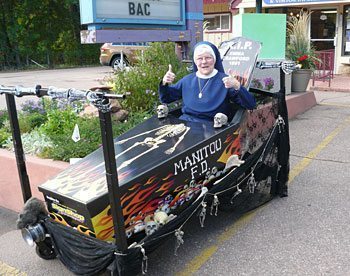
Onaledge has been the site of a lot of paranormal activity over the years, and a television crew that went there to investigate picked up numerous voices on their EVP (electronic voice phenomenon) devices (watch the video).
One member of our party felt the presence of a spirit that crawled into bed with her, but up on the highly-haunted third floor, I didn’t see or hear anything. That may be because I’m a “brick” — someone who can’t perceive paranormal activity.
Still, there are so many stories of certain familiar spirits making themselves known again and again. One woman fled the room I stayed in after hearing five different voices, and Moe says the housekeeper won’t go in there alone.
She also suggested we look at our photographs for ‘orbs.’ Apparently, they have appeared in many people’s photos. They say spirits appear as orbs when photographed with a flash. I didn’t find any in my pictures from Onaledge, but two of them appeared later in a shot of the ballroom at the Stanley Hotel.
Emma Crawford and the Coffin Races
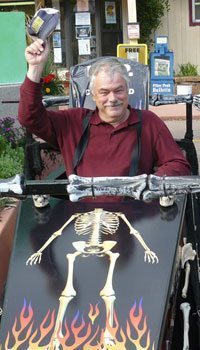
Manitou Springs is a friendly town with the Rockies springing up all around it, and it’s the site of the famous coffin races which take place every year in October.
These races are held in honor of Emma Crawford, who came to town in the 1880s to ‘take the waters’ because she was suffering from TB. She came to love the area, especially Red Mountain, which rises steeply from the north end of the canyon.
Even though she was gravely ill, she snuck off one day and climbed Red Mountain, leaving her red scarf tied to a tree to prove her accomplishment. She also asked her fiance to see that she was buried there.
She seemed to be recovering, but unfortunately, she relapsed and died, and her fiance kept his promise, enlisting 12 sturdy friends to carry her remains to the summit. Emma’s remains were relocated to the other side of the summit when a railroad was built to the top in 1912.
Years later, in 1929, heavy rains and erosion caused her coffin to come sliding down the mountain, and her remains were found at the base, along with the silver handles of the casket. The remains were reinterred in the local cemetery, and the community holds the coffin races every year in her memory, as well as a reenactment of her wake.
Fifty teams compete in the main event, with four ‘pallbearers’ pushing a racing coffin made to exact specifications and containing one passenger, known as the “Emma,” down the main street of town. There’s also a separate event for area fire departments.
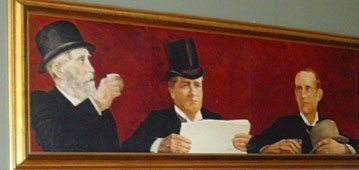
Some enter the event for fun, but many compete very seriously. The town makes a festival of it, with a parade, sidewalks sales and lots of fun events.
The Oxford Hotel
Our next stop was the historic Oxford Hotel in Denver, built in 1891, right next to Union Station, where all the tycoons gathered to smoke cigars back in the day. A visit to the Oxford is a trip to the Gilded Age when Denver was a booming mining town.
The magnificent architecture of Frank E. Edbrooke, the antique furnishings, and an extraordinary collection of Western art give the hotel a museum-like quality — a bit of living history. The hotel’s art collection includes works by by John Dare Howland, John Fery, Charles Partridge Adams and numerous other artists.
But if you’re a single male, you probably don’t want to stay in Room 320. You might get a little more history than you bargained for. Numerous male guests have reported having their arms pulled and the bedclothes torn off the bed.
It was in this room in 1898 that a young woman named Florence Montague shot and killed her lover before turning the gun on herself. He was married — she didn’t mind that so much — but then he cheated on her, and that was too much to bear.
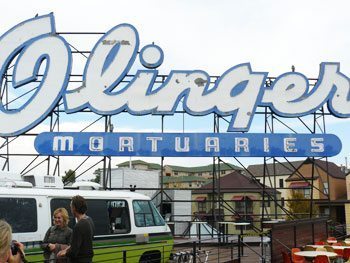
The bartenders at the Cruise Martini Bar at the Hotel also tell of a man in an old postal uniform who comes in and orders a beer and drinks it and then leaves muttering something about getting the gifts to the children.
Turns out there was a postal worker in the 1930s who was delivering Christmas presents to Central City about 35 miles away. When he never arrived, people thought he had sold the gifts and kept the money.
In the spring they found his decomposed remains alongside the children’s presents. Spooky!
Lunch at a Former Mortuary
We had lunch at a fantastic restaurant in Denver’s LoHi District called Linger. Talk about hip! It’s located in an old mortuary; there’s a terrace on the roof with great views of the city and an RV serves as a bar.
But the real highlight is the menu: braised goat tacos, red lentil dahl, watermelon & mozzarella Caprese, Wagyu beef sliders, sweet potato waffle fries — this is my kind of place!
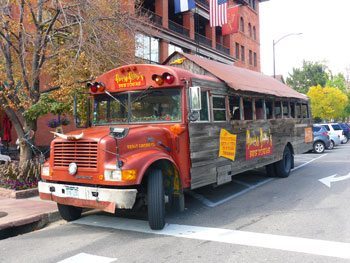
For dessert we had strawberry rhubarb crepes, salted butterscotch pineapple pudding with lemongrass cotton candy, and chocolate peanut butter pudding — mmmm…
The building used to house Olingers Mortuary, but they’ve changed the neon sign to read “Eatuary.” You can even have a Dead Guy Ale.
Touring Boulder with Banjo Billy
From there it was on to Boulder, affectionately known by Coloradans as “seven square miles surrounded by reality.” It has a reputation similar to Berkley, California, or the People’s Republic of Cambridge, Massachusetts. I think it has something to do with being a university town.
At the city’s storied Hotel Boulderado, we met up with Banjo Billy and his tour bus, which looks like a hillbilly cabin. Inside it’s furnished with really comfortable upholstered armchairs, and because he’s registered as a limousine, you can drink beer on the tour!
Billy has history, crime and ghost tours. We took the ghost tour, naturally, and it was very well researched and well presented, from the overzealous 40-year-old boy scout who answers the telephone after hours at scout headquarters to the manager of the Boulder Theater who accidentally hanged himself while adjusting the lights.
It was a kick to drive around town in the comfort of our hillbilly living room. After a visit to the Hotel Boulderado and it’s famous Catacombs Bar, it was off to Colorado’s most famous spooky place: the Stanley Hotel in Estes Park, which inspired Stephen King’s book, The Shining, and the famous Stanley Kubrick film.
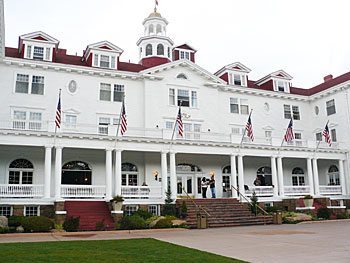
The Stanley Hotel
When F.O. Stanley came to Colorado in 1903, he and his wife Flora fell in love with Estes Park, one of the most beautiful places on earth, and here they built the magnificent Stanley Hotel. John Philip Sousa performed at the opening of the hotel in 1909, and the guests included Theodore Roosevelt, J.C. Penney, Harvey Firestone and the Emperor of Japan.
F.O. and Flora, who had no children, held special events for the children of Estes Park, and let them ride at their stables, and in some cases even paid their college tuition.
They had a fleet of Stanley Steamers that transported thousands of guests through the narrow passes into this secluded mountain valley where, by all accounts, a good time was had by all for many wonderful years. No wonder so many spirits have come back.
Ghost hunters from all over the world have come to the Stanley, and have found very high levels of paranormal activity, particularly in the concert hall.
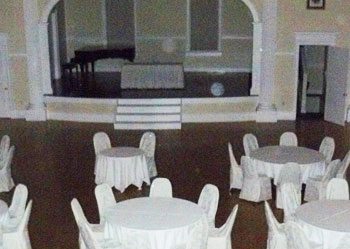
Stephen King stayed here in 1982, in Room 217, and had a nightmare about his three-year-old son being chased through the corridors. This formed the inspiration for his terrifying book, The Shining.
The staff, including Madame Vera, the resident psychic, speak of numerous familiar spirits, including Mrs. Stanley, who is identified with the fragrance of roses and likes to play the piano in the concert hall, Billy, one of the fun-loving children on the fourth floor, and Elizabeth Wilson, a former housekeeper who literally climbs into bed with unmarried couples and pushes them apart.
And they don’t make the slightest effort to convince you that these spirits exist. The spirits are clearly a fact of life for them.
One of my fellow travel writers told Madame Vera about a spirit who was, how to put this, overly friendly. Then she smelled roses. Madame Vera rolled her eyes — apparently, there’s a spirit who is known for this kind of thing — and she said, “That was Mrs. Stanley. She saved you.”
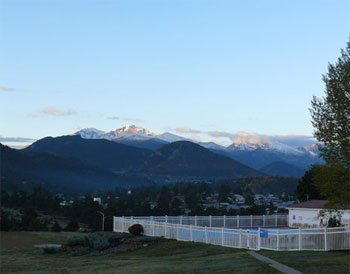
Many people have heard humming, singing and sighing in the concert hall, which is thought to be a young woman named Lucy. The building fell into disuse for a time in the 1970s, and Lucy, who seems to have been a runaway, was squatting in a room in the basement when she passed away.
We took the evening ghost tour of the concert hall with our guide Rob Kittler, and I got a photo of two ghostly orbs. Apparently, spirits travel in orbs, like Glinda the Good in the Wizard of Oz. And I heard a ghost speak — very distinctly — through this EVP (electronic voice phenomenon) device.
You can hear a lot of indistinct sounds from these devices which sound like different words to different people, like playing Beatle records backwards, but as we were sitting in Lucy’s room in the basement of the Concert Hall, just as a little mouse scurried by in the corridor, we heard a voice say, quite unmistakably, “a mouse.”
In the morning I woke up early and full of energy — the mountain air does that — and I heard a very weird sound outside my window, something like a flugelhorn. It was a male elk bugling. I went out to take some photos of the morning sun.
Isabella Bird, back in 1876, wrote of Long’s Peak: “It is one of the noblest of mountains, but in one’s imagination it becomes invested with a personality. The thunder becomes its voice and the lightning does it homage.
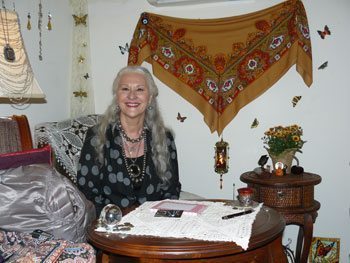
“Other summits blush under the morning kiss of the sun and turn pale the next moment. Long’s Peak detains the first sunlight and holds it round its head for an hour at least, till it pleases to change from rosy red to deep blue.”
After breakfast, we had a chance to meet with Madame Vera, who has been doing consultations in Estes Park for 25 years. She had an office in town, and when it was destroyed by fire, the Stanley invited her to use a room there.
She answers questions people have about their love life or their business, connects with loved ones and helps clients with unexplained mysteries.
She said she first learned she had unusual powers of perception when she went to a funeral with her father as a little girl. She actually saw the spirit of the deceased appear and object to the presence of one of the guests as if to say, “What’s that guy doing here? He’s not my friend!”
Madame Vera says she likes the pleasant side of psychic consultations — people’s love lives or their fortunes — and refuses to be drawn into the spooky or macabre. “I don’t do ugly,” she says.

She says it’s pretty easy to make the spirits mind their manners. You can snap your fingers or clap your hands and give them sharp commands. Or just call Mrs. Stanley, and she’ll make them behave.
The scenic splendor, the grandeur of the hotel, the clear, invigorating air, the elk grazing on the front lawn, the graciousness of the Stanleys and their spirit guests — Estes Park more than lives up to its reputation.
Fort Collins
Our next stop was another hip college town, Fort Collins, in the foothills of the Rockies. Built on orders from President Abraham Lincoln in 1864 to guard army payrolls being transported up the Cache La Poudre River, the city is home to Colorado State University with some 30,000 students.
The city also has nine breweries which you can visit on their Foam on the Range tour. These breweries produce 70 percent of Colorado’s craft beer, some of which we sampled at Coopersmith’s Pub and Brewing before checking into the historic Armstrong Hotel, which was restored and reopened in 2004 by the Levinger family.
Wandering along the wide pedestrian-friendly boulevards in the center of town, I was struck by how much great public art was on display, and by the diversity of the pedestrians — everything from cowboy hats to blue hair and multiple piercings. The city is full of interesting shops, restaurants, cafes, antique stores, museums, and theaters.
We toured the haunted spots of Fort Collins, appropriately enough, in a hearse provided by Fort Collins Ghost Tours, and our guide, Shane Sheriean was dressed up as an undertaker.

We learned all about lynchings, murderers, adulterers, murderous adulterers, and all kinds of spooky doings, including a haunted fraternity house at Colorado State.
We dined at Austin’s American Grill, where I enjoyed a superb buffalo meatloaf, and then Sheriean took us on a walking tour of the downtown area. We visited the yard of the city’s old courthouse where James Howe was lynched in 1888 after brutally murdering his young wife Eva.
“Much as lynch law is to be deplored in the abstract,” the local newspaper opined, “yet there are times, or at least, seem to be, when the checking of crime can be accomplished in no other way.” The murder and lynching also prompted the citizens to form an organization to prevent domestic violence.
We also went to the site of the old Linden Hotel, now occupied by Nature’s Own, a science and nature store, where there have been sightings of the proverbial hooker with a heart of gold — a female spirit that appears only to children.
I had a wonderful time on my Spooky Colorado tour, but the spooks were only part of the fun. I also really enjoyed the spectacular scenic splendor of the place, the friendliness, and hospitality of the people and the warm and welcoming communities.
- Greater Palm Springs: Art, Architecture, and Family Fun - April 11, 2019
- Derry, Northern Ireland: Fun and Festivals in the Walled City - August 14, 2018
- Georgia’s Film Industry is Booming - August 18, 2017





